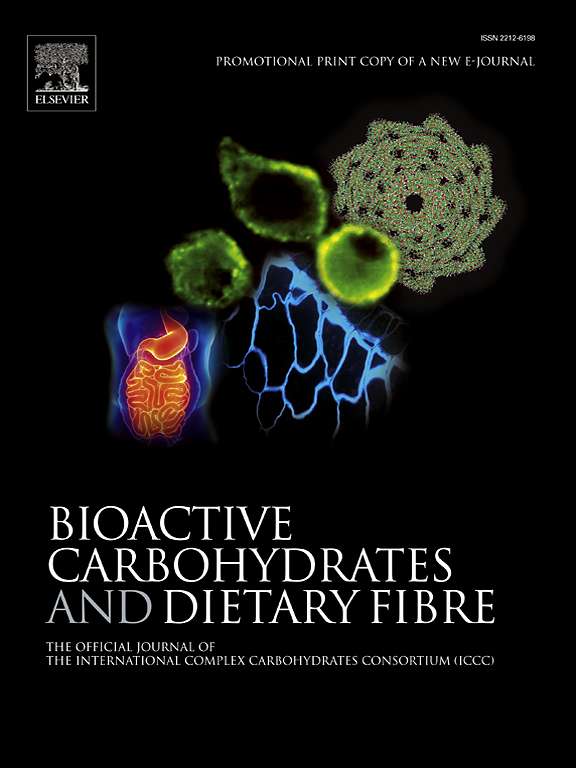Exploring potential of aloe vera and sterculia gum dietary fibers to develop functional hydrogels for drug delivery applications
IF 3.6
引用次数: 0
Abstract
Now days the main focus of carbohydrate research is to design functional hydrogels for biomedical applications. The aloe vera (AV) and sterculia gum (SG) are therapeutically active dietary fibers. Herein, these polysaccharides were explored to develop network hydrogels by covalent and non-covalent interactions for use in drug delivery (DD) and wound dressing (WD) applications. These hydrogel dressings were impregnated with antibiotic drug moxifloxacin for better wound care. Slow and sustained diffusion of drug was found with a non-Fickian mechanism and release profile was best explained by Higuchi kinetic model. Additionally, various physiological and biomedical properties of hydrogels were also evaluated. The dressings exhibited an impressive wound fluid absorption tendency under simulated conditions. The network structure demonstrated mucoadhesive properties and required 97 ± 6.00 mN forces for the detachment of dressings from mucosal surface. Dressing revealed significant antioxidant activity which demonstrated 49.14 ± 0.32 % free radical scavenging in DPPH assay. The dressings were non-toxic and were permeable to O2 & H2O. The characterization of hydrogel dressings was performed through Field emission scanning electron microscopy/Energy dispersive spectroscopy (FESEM/EDS), Atomic force microscopy (AFM), 13Carbon Nuclear magnetic resonance spectroscopy (13C NMR), Fourier transform infrared spectroscopy (FTIR) & X-ray diffraction (XRD) techniques to establish the structural aspects of copolymers. Overall, physicochemical & biochemical findings suggested that these hydrogels could be applied in DD applications. These hydrogels developed from bioactive AV and SG could be applied as wound dressings encapsulated with antibiotic drug for better wound healing.
探索芦荟和树胶膳食纤维在开发药物递送功能水凝胶方面的潜力
目前碳水化合物研究的主要焦点是设计生物医学用途的功能性水凝胶。芦荟(AV)和树胶(SG)是具有治疗活性的膳食纤维。在这里,这些多糖被探索通过共价和非共价相互作用来开发网络水凝胶,用于给药(DD)和伤口敷料(WD)应用。这些水凝胶敷料浸渍了抗生素药物莫西沙星,以更好地护理伤口。药物的缓慢和持续扩散具有非菲克机制,释放曲线最好用Higuchi动力学模型来解释。此外,还对水凝胶的各种生理和生物医学特性进行了评价。在模拟条件下,敷料表现出令人印象深刻的伤口液吸收倾向。该网络结构表现出粘接性能,需要97±6.00 mN的力才能将敷料从粘膜表面分离。在DPPH实验中,敷料显示出显著的抗氧化活性,其自由基清除率为49.14±0.32%。该敷料无毒,可透氧;H2O。通过场发射扫描电镜/能谱(FESEM/EDS)、原子力显微镜(AFM)、13C核磁共振谱(13C NMR)、傅立叶变换红外光谱(FTIR)和amp对水凝胶敷料进行表征。x射线衍射(XRD)技术建立共聚物的结构方面。总的来说,物理化学& &;生物化学结果表明,这些水凝胶可用于DD的应用。由生物活性AV和SG制备的水凝胶可作为包封抗生素药物的伤口敷料,促进伤口愈合。
本文章由计算机程序翻译,如有差异,请以英文原文为准。
求助全文
约1分钟内获得全文
求助全文
来源期刊

Bioactive Carbohydrates and Dietary Fibre
Agricultural and Biological Sciences-Food Science
CiteScore
6.00
自引率
0.00%
发文量
38
期刊介绍:
 求助内容:
求助内容: 应助结果提醒方式:
应助结果提醒方式:


